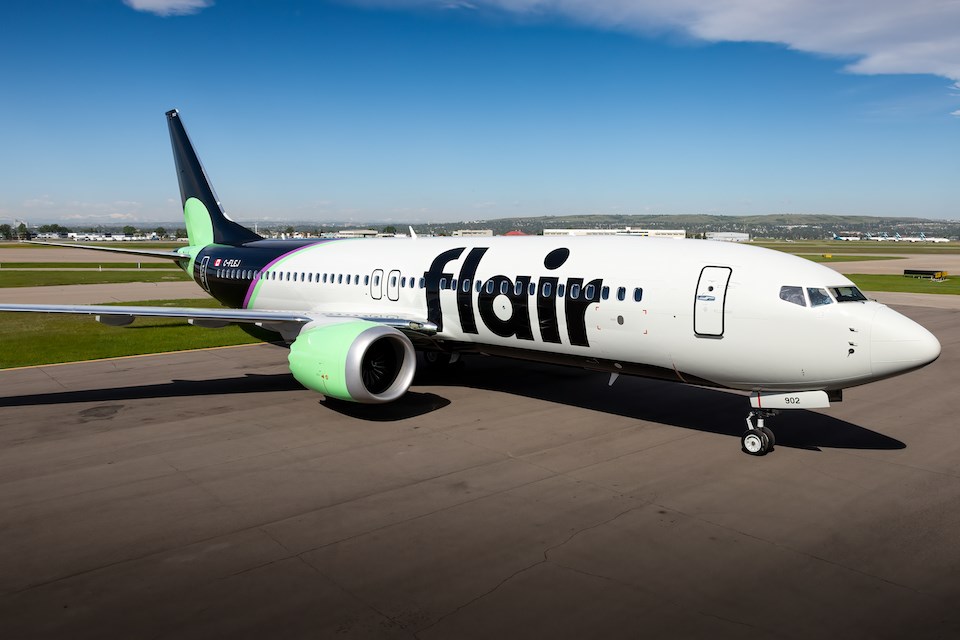Flair Airlines has increased flights on several routes from Â鶹´«Ã½Ó³»to destinations across Canada and a popular Mexican city but dropped a route to a popular U.S. city.
Canada's ultra-low-cost carrier announced its 2025 winter schedule changes on Thursday, March 27, citing a reduced interest in United States travel amid the trade war and political tensions; the airline is "going all-in on True North travel."
The Edmonton-based carrier increased flights on four key routes from Â鶹´«Ã½Ó³»International Airport (YVR), including to Calgary (up 40 per cent), Toronto (up a staggering 82 per cent), Winnipeg (up 40 per cent), and Guadalajara, Mexico (up 33 per cent).
Flights from Edmonton to Â鶹´«Ã½Ó³»also increased by 25 per cent, and flights from Edmonton to Abbotsford increased an impressive 90 per cent (from 11 flights weekly in 2024 to 21 in 2025).
Flair responds to Canadian shift from U.S. leisure travel
Eric Tanner, Vice President of Commercial, tells V.I.A. that Flair alters its schedule in response to demand, reducing flights on less popular routes or nixing them entirely.
He says reducing the number of flights on some U.S. routes has allowed the airline to reallocate them to other domestic or international ones. The airline has also removed the Vancouver- Palm Springs route from its summer 2025 schedule.
For instance, the route connecting Kelowna and Calgary is no longer seasonal, with the airline shifting to a year-round schedule. Additionally, it has reinstated the seasonal route connecting Toronto and Charlottetown, when it previously announced it wouldn't return for 2025.
"Every single market adjustment is all about supply and demand," he explains. "And this past season, we did not see the demand that we needed out of Palm Springs, and every market needs to earn its way into our network.
"We hope to return to Palm Springs in the future. It's a wonderful destination and a great place to visit, but given limited aircraft availability, we need to make sure that every flight performs its way to our network."
Flair reports an overall drop in demand for U.S. destinations, although it is more concentrated around leisure destinations, such as Florida, Arizona, California, and Las Vegas. However, a few select U.S. cities, including Los Angeles, San Francisco, and New York, continue to draw travellers.
"It's no secret that demand between Canada and the U.S. is down compared to where airlines would expect it to be," he notes.
Will Flair make more cuts to U.S. routes in the coming months?
Flair has made other adjustments to its U.S. flight schedule, reducing capacity to destinations, including Florida and Arizona. For now, the airline doesn't plan to make any other changes.
Tanner says a few markets will end earlier than previously scheduled, such as routes finishing at the beginning of April instead of the end. Some U.S. flight frequencies have also been reduced.
"All those cuts, though, have been redeployed into domestic capacity," he notes. "So the beauty of airlines is that we all have mobile assets, and if demand is lower than expected in one part of the world, we can redeploy our assets to where we are seeing strong demand."

Tanner says it is too soon to comment on possible new international destinations that Flair may add to its roster as U.S. travel wanes.
"We're always evaluating different opportunities," he notes. We're certainly very pleased with the overall trajectory of our Mexico service, and we're certainly evaluating a few different opportunities in Mexico."
For now, the airline is primarily focused on adding depth to existing routes, increasing frequency to its top destinations.
Flair is the only remaining low-cost carrier, although other airlines have adopted similar policies
Flair is now the only true remaining low-cost carrier in Canada following WestJet's dissolution of its budget brand Swoop in 2023 and the unexpected shutdown of in February 2024, which stranded hundreds of travellers.
Customers have voiced concerns about the airline's potential as travel demand dips, citing drastically low fares and the dissolution of other budget brands. However, then-CEO Stephen Jones told V.I.A. in a 2024 interview that the company relied on more than ticket sales for seats, with 40 per cent of its overall revenue derived from ancillary revenue.
Former Chief Operating Officer Maciej Wilk became Flair's interim CEO following Jones' 2024 retirement.
Tanner added that Flair feels confident in its current schedule and that "the lion's share" of its current profits come from seat sales with ancillary revenue, including extras such as Buy on Board, cushioning the remainder. The airline is also seeing an uptick in return travellers, which he says speaks to growing confidence in the brand.
Air Canada and WesJjet have also recently adopted low-cost carrier policies, dropping free carry-on bags and removing complimentary seat selection during the 24-hour pre-flight check-in.
"I guess the question is, if we're all offering the same product, why is our product still significantly lower [priced] than theirs? Or maybe, if I were to frame that a different way, why are they still charging so much if they're degrading their product? If you're not going to charge for carry-on, that's great, but you need to do that while offering a very low fare," he comments.
Find more information about exciting destinations in B.C. and across the globe, as well as travel deals and tips, by signing up for V.I.A.'s weekly travel newsletter The Wanderer. Since travel deals can sell out, find out the day they are posted by signing up for our daily Travel Deals newsletter.
Want to learn more about a specific destination or have a travel concern or idea you would like V.I.A. to write about? Email us at [email protected]. Send us stories about recent holidays that you've been on, or if you have any tips you think our readers should know about.



